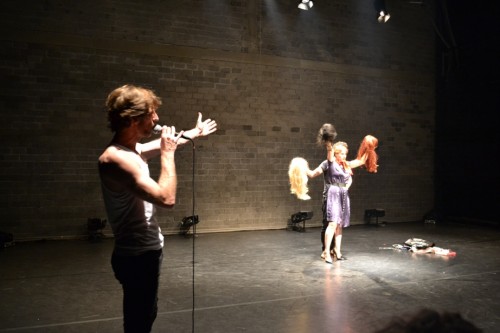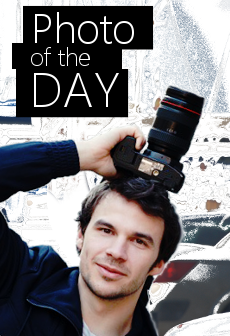Interview with the French choreographer and dancer Fabien Prioville by Dessislava Berndt
Of course, when you live in Wuppertal and like Pina Bausch’s work, you are always curious to discover everything regarding the dance company and the activities of the former dancers- especially after Pina Bausch has passed away.
Fabien Prioville is more than a former dancer of the company where he was a member for seven years. Fabien Prioville graduated at the Centre National de Danse Contemporaine (CNDC) in Angers. He later worked with Édouard Lock and his company ‘La La La Human Steps’ in Canada, before he joined Philippe Blanchard in Stockholm. In 1999 he became a member of Pina Bausch´s Tanztheater Wuppertal.
He has been working as a freelance dancer and choreographer since 2006. He has worked together with Josef Nadj and Davis Freeman, among others. Various commissioned works brought him to New York’s Juilliard School, as well as to Japan and Australia.
In 2010 he founded the Fabien Prioville Dance Company. Since then he has created six productions, e.g. his first solo �������Jailbreak Mind” which was co-produced by tanzhaus NRW and Trafó Budapest.
“Experiment on chatting bodies” was my first contact with the Fabien’s work.
I was fascinated by the fresh and unusual performance of Pascal Merighi and Fabien Prioville in front of us on the stage in Germany, as well as by the live connected people joining the performance via Skype.
Then, I followed him to see the following three pieces:
“The Smart Phone Project”, where the audience actively took part in the piece, using a special designed app by the Bonner Fraunhofer- Institut f��r Angewandte Informationstechnik;
“Time for us”, where he and his wife Azusa shared with us their experience as a couple and
"time for us" Trailer 1 from fabien prioville dance company on Vimeo.
�����������SOMA”- unexpected performance with former dancers of Tanztheater Wuppertal Pina Bausch and Japanese artists from different fields where he showed two important aspects of his life – his experience as a dancer with Tanzhteater Wuppertal and his strong connection to Japan.
Finally, the decision to give more attention to this exceptional performer and choreographer and his work and to present him in our magazine comes naturally. I met Fabien in Wuppertal where he kindly answered my questions about his projects and plans.
Fabien, you used technology in some of your pieces e.g. Skype in “Experiment on chatting bodies”, Smart Phone App in “The Smart Phone Project” and infrared camera in �����SOMA���. Why and what does this mean to you?
When I think about Skype and smart phones, I call them social technologies that are used by everybody. And I find that interesting because they are in everybody’s hand and everybody can be connected to them in the performance. For example, in ���Experiment on chatting bodies������� we start the piece with a woman speaking on Skype, accompanied by some noise, and we think that the connection is bad and we cannot understand her voice very well. And everybody has an experience talking to someone on Skype having bad connection and constant interruption.
When I used this technology in the performance I had the feeling that I can speak as loud as I can but I cannot use this technology that we all have and share, so people can imagine themselves with their own experience on such technology.
For me, in all this technology the social human factor remains at the end of our discourse, our connection and what we say about society and communication between each other. It is about creating a comment on stage and reach out to other people, everything is virtual, not real and trying to play and to expose these two realities.

Time for us, Photo: Mischa Lorenz
And also in “Smart phone project����������� the main idea is the same: it is about the smart phone being an extension of the human. I was interested in playing with this extension and bringing it to the theater. I have to work with it in a very specific way.
�����Time for us������� has no guideline, no comments that I like. It is an impression of things.
SOMA was another special project and a big challenge how to bring together two different cultures and two groups of individuals with all their experience. And the Japanese people were not dancers, but only actors: it was about how to communicate with the body and translate it. So, with the infrared camera we were trying to look deeper into the body and create some kind of unified texture where the whole backgrounds and culture arise and become abstract.
In SOMA you weren�����t on stage as a dancer. Why?
People are not so used to it in Germany, but I�����������ve done a lot of pieces where I am not on stage. In SOMA we had 10 people on stage and I needed to have the distance and the control from outside. So, I took the decision at the beginning to do it that way.
And of course, it can happen again in other pieces. The choreographer can be the part of the piece on stage or not. I like both ways. For me, it is just a different approach to do a piece.
What about the work with other artist and the former Pina Bausch dancers?
In SOMA, my former colleagues came to Japan and shared their lives with the Japanese people. I was happy that Thusnelda and Clementine could find their space to exist in this particular constellation.
I might work in future with Pascal and might bump into Thusnelda and Clementine again. They are wonderful performers and also friends.
And my wife is working for Pina and is very busy, but is always next to me, working with me, assisting me when possible.
How do you create a piece?
I get ideas for my pieces basically from the things around me- things in my life, things I am concerned about or things I see, because I like observing people and society a lot. I like talking about human beings and what has sense and influence on what we are. It could be literally everything as long as I think it is valuable for a performance.
As soon as I start thinking about a certain idea I start thinking about the experience the audience will have. My work is not so much about me and making people understand my concept, it is about the audience experience. I imagine myself as the audience when I create the piece.
Also, it is about what kind of experience I decide to give the audience with this piece.
I took care about my choices doing SOMA and worked very carefully because it is very different work from what people have seen from me till now. But it is ok, because for me every piece is an attempt to get new experience.
You and Azusa presented shortly �����Time for us��� in Atlanta. How was it there?
Two years ago I was invited by Lauri Stallings to talk about my work and in regard to the film “Pina” from Wim Wenders. This year she invited me again and we presented “Time for us” at the Goat Farm Arts Center. In Atlanta we had three shows and the audience was gave us a very warm reception. Every night we had standing ovations, the people were super excited about the piece.
"time for us" Trailer 2 from fabien prioville dance company on Vimeo.
Please, let us know about your future plans.
I just want to continue to work on new pieces. I would like to find a group of people to work with more frequently, more regularly. But, on the other side, I don’t like the routine, I like to put challenges on myself, to rethink my work each time, because I don’t like to repeat myself. I think in everything I do, you can see some connection, because at the end of the day it is me making choices and being the artistic director. But people cannot really categorize me. I like being surprising and making people curious about my new work.
I work on a new piece for 2017 where I am going back to my roots and it is the part of the cycle how to deal with the memory and the heritage of Pina Bausch���s work. And it will be the last closing chapter for me talking on this.
How can you estimate the influence of Pina Bausch work for your development?
My all pieces had nothing do to with Pina Bausch. But my next piece will have very much with Pina Bausch, on purpose.
What influenced me the most working for Pina Bausch was to be a creator and to understand the process of being a creator; how through the work and watching her I can be my own creator. And, a bit like her, to be the person who wants to take care about everything ������� Music, Scenography, Lights, Stage.
There was never only Pina Bausch in my life. There were also La La La Human Steps and other choreographer and influences.
Who inspires you?
Performances in general have inspired me. Pina Bausch is my biggest inspiration. Ivo Dimchev Solo work, Josef Nadj, Philippe Blanchard����������������������������������� But I don���������������t have an icon.

The Smart Phone Project, Photo: Fabien Prioville Dance Company
Do you have other passions?
Technology. Music.
How do you choose the music for your pieces?
I either work with musicians or I search it by myself. In SOMA I had fantastic musicians who played live on stage. And for the next piece it is going to be even better, more classical – with piano, drum, vocals and clarinets. And again live on stage. I enjoy it very much, but I like to work also with recorded music because of the easier handling.
How do you archive your work?
I have a good body memory. And I take videos from my performances.


The Smart Phone Project, Fotos: desenze
What about your experience with other artist?
SOMA was a surprising experience, because I had to work with young people but also with a 72 years old person. It was amazing to see the ability of that body. She was an incredible woman. She worked with Klaus Kinski many years ago. And she is very active. We did an audition in Tokio where we found the Japanese artists for SOMA.
What is the most important thing you would like that people should know about you?
I will never stop. Just watch out for me. Because I am coming:)
What is the biggest challenge for you?
I am French, I speak English with my Japanese wife, I am trying to make choreography. It is very international, because although I live in Germany I am also living with the rest of the world. I do a lot of work with Japan, I am starting to do more and more in France, in the UK.
I belong to nowhere, because I like to be in other places and to always get new experiences.

Time for us, Photo: Mischa Lorenz
You will be in Paris at the beginning of December. Are you scared?
I think about it. I don’t give into fear because it will be serving the terrorist. The French people, we are fighters from our history. And they cannot make us scared. We are very selfish people and somehow arrogant, but this save us because we are stronger than the terrorists.
So, I believe it is not my destiny to die in Paris in December CENTQUATRE-PARIS is a very prestigious place and known theater and I am happy to present “The Smart Phone Project������� there.
Fabien, thank you very much for the interview and good luck for all your projects!











